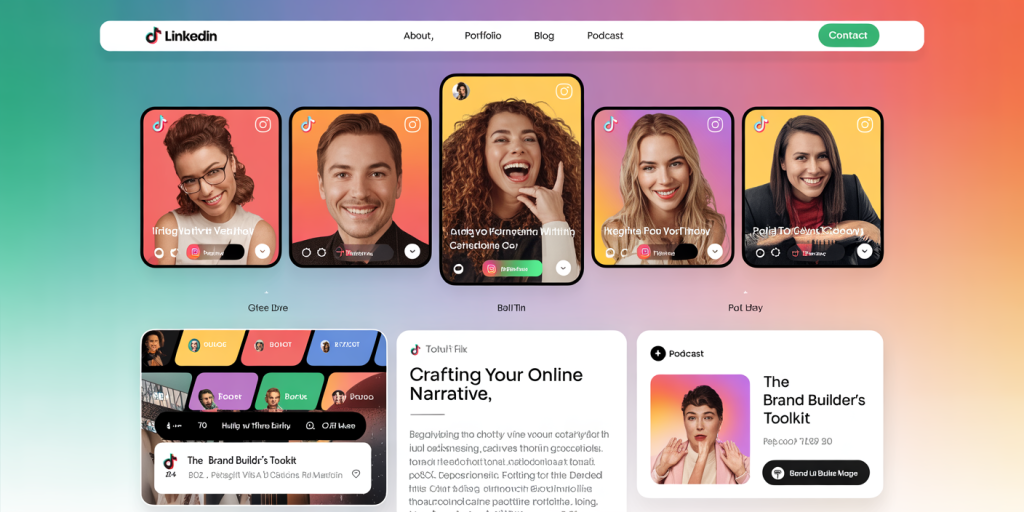How to Create a Personal Branding Strategy Online
In today’s hyper-connected world, establishing a strong personal brand online is no longer optional but essential. Whether you’re a freelancer, entrepreneur, or professional climbing the corporate ladder, a carefully crafted personal branding strategy can set you apart, attract opportunities, and establish credibility. According to a study by LinkedIn, 70% of employers use social media to screen candidates during the hiring process, signaling the importance of an impactful online presence. This article explores actionable steps and proven methods to help you build a compelling personal brand that resonates with your target audience.
Understanding the Importance of Personal Branding in the Digital Era
Personal branding is the deliberate practice of positioning yourself as a thought leader, expert, or trusted professional in your niche. In the digital realm, your personal brand is essentially the image and reputation that precede you before any direct interaction. The rise of platforms such as LinkedIn, Twitter, Instagram, and even TikTok offers unprecedented opportunities to share your expertise, engage with communities, and showcase your values.
Consider the example of Gary Vaynerchuk, who transformed his personal brand from a family wine business owner into a global digital marketing mogul. His consistent, authentic content strategy and engagement on platforms like YouTube and Instagram have garnered millions of followers and numerous business ventures. His case underscores that successful personal branding is rooted in authenticity, consistency, and strategic outreach.
Creating a personal brand online is also a hedge against career uncertainties in today’s gig economy. Data from Upwork predicts that by 2027, freelancers will comprise 50.9% of the U.S. workforce. Digital personal branding can increase visibility in a crowded market, attracting clients, collaborators, or employers eager for professionals with standout digital personas.
Defining Your Unique Value Proposition (UVP)
Before diving into content creation or social media, it’s crucial to clearly define what makes you unique—the core differentiator that shapes your brand identity. Your Unique Value Proposition (UVP) communicates what you offer, how it benefits your audience, and why they should choose you over others.
Start by conducting a thorough self-assessment. Reflect on your skills, experiences, passions, and values. Tools like SWOT analysis (Strengths, Weaknesses, Opportunities, Threats) can help distill your strengths and areas of expertise relative to market demands. For example, if you’re a digital marketer with a passion for sustainability, your UVP could be helping eco-friendly brands thrive through innovative social media strategies.

Another practical approach is to analyze your competitors or peers to identify gaps or unique angles. For instance, while many digital marketers focus on traditional sectors, specializing in green marketing could serve as a niche for your personal brand.
Comparative Table: Generic vs. Unique UVP Example
| Aspect | Generic UVP | Unique UVP |
|---|---|---|
| Skills | Digital Marketing Specialist | Digital Marketer specializing in sustainable brands |
| Audience | Small and medium businesses | Eco-conscious startups and green businesses |
| Value Offered | Increase online engagement | Drive brand loyalty through authentic, sustainability-driven campaigns |
| Differentiator | General marketing knowledge | Combining marketing expertise with environmental ethics |
This clear articulation of your UVP guides your content creation, communication style, and platform choice, ensuring all elements of your personal brand align.

Crafting a Consistent and Authentic Online Presence
In personal branding, consistency and authenticity are non-negotiable. Consistency builds recognition, while authenticity fosters trust. Your online presence encompasses your social media profiles, website, blog, content, and interactions with followers.

Begin by choosing platforms that best align with your target audience. For professionals and B2B services, LinkedIn is indispensable. For creatives or lifestyle brands, Instagram or TikTok might be more effective. For example, Neil Patel, a digital marketing expert, leverages his blog, YouTube channel, and LinkedIn to share consistent expertise, reinforcing his authority.
Ensure consistent branding elements such as profile photos, color schemes, and tone of voice. Visual consistency makes your profile instantly recognizable, while tonal consistency ensures your messaging stays coherent whether you’re posting a LinkedIn article or a tweet.
Equally important is authenticity. Audiences value real stories and genuine interactions over overly polished marketing. Sharing personal insights, challenges, or lessons learned can humanize your brand. Brené Brown, a research professor and author, built a powerful personal brand by vulnerably sharing her research on vulnerability and courage through podcasts, talks, and books, creating deep connection with followers.
Developing and Sharing High-Value Content
Content is the cornerstone of an effective personal branding strategy. It not only demonstrates your expertise but also adds value to your audience, encouraging engagement and fostering a loyal community.
Identify the topics that your target audience cares about and that align with your UVP. Use keyword research tools such as Ahrefs or SEMrush to find relevant, high-traffic terms related to your niche. For example, a career coach might create content around “improving LinkedIn profiles,” “negotiating salaries,” or “career transition tips.”
Diversify content formats to appeal to different audience preferences. Written articles, videos, podcasts, infographics, and live sessions each have their strengths. According to HubSpot’s 2023 content trends report, video content generates 85% more organic reach than text on Facebook and Instagram, suggesting a strong emphasis on visual content may boost brand visibility.
Regularity also matters. Posting consistently (e.g., twice a week) keeps followers engaged and signals activity to algorithms, improving reach. Real-world brands like Marie Forleo exemplify this—through weekly YouTube videos, newsletters, and social media posts, she has cultivated a massive, engaged following.
Example: Content Calendar for a Personal Brand (Career Expert)
| Day | Content Type | Platform | Topic | Purpose |
|---|---|---|---|---|
| Monday | Blog Post | Website | “Top Interview Tips in 2024” | SEO, authority building |
| Wednesday | LinkedIn Article | “How to Network Remotely” | Professional engagement | |
| Friday | Instagram Reel | “Quick Resume Hacks” | Visual engagement | |
| Sunday | Newsletter | “Weekly Career Advice Roundup” | Community building |
Using structured content calendars fosters discipline and ensures alignment with your brand goals.
Networking and Engaging Strategically
Building connections and engaging with your community are powerful ways to amplify your personal brand. Online networking extends beyond merely accumulating followers—it means building meaningful relationships that can boost your influence and credibility.
Participate actively in relevant groups, forums, and chats related to your field. LinkedIn Groups or niche subreddits provide excellent venues to contribute knowledge, answer questions, or join industry discussions. For example, marketing expert Ann Handley frequently engages with followers on LinkedIn, not just by posting content, but through thoughtful responses and participation in conversations, reinforcing her authority and approachability.
Collaborations and guest appearances add another layer to networking. Guest blogging, podcast interviews, or joint webinars expose your brand to new audiences. Statistics from a 2022 Edelman Trust Barometer reveal that people often trust peers and collaborators more than brands themselves, making these joint ventures powerful trust builders.
Strategic engagement also involves monitoring your brand mentions and responding to comments or messages promptly. Tools like Mention or Brand24 notify you when your brand is discussed, giving you opportunities for timely interaction and reputation management.
Harnessing Analytics and Adapting Your Strategy
No branding strategy can succeed without data-driven adjustments. Analytics provide insights into which content resonates, what drives engagement, and where growth opportunities lie. Most social platforms offer built-in analytics dashboards, such as Instagram Insights or LinkedIn Analytics, showing follower demographics, post performance, and engagement rates.
For instance, if your Instagram Reels outperform static posts by 50% in reach, it makes sense to allocate more resources toward video production. Google Analytics on your personal website can reveal traffic sources, time spent on pages, and conversion metrics such as newsletter sign-ups or contact form completions.
Establish monthly or quarterly reviews to evaluate these metrics against your brand goals. Consider A/B testing different types of content or posting times to optimize reach and engagement further.
| Metric | What it Shows | Actionable Insight |
|---|---|---|
| Engagement Rate | Likes, comments, shares per post | Identify content types with highest traction |
| Follower Growth | Net increase in audience size | Assess if current strategy attracts new followers |
| Website Conversion Rate | Percentage of visitors completing goals | Improve calls-to-action or user experience |
| Reach and Impressions | Number of unique views | Expand or refine targeting |
Continuous adaptation ensures your personal brand remains relevant and impactful as platforms, trends, and audience preferences evolve.
Future Perspectives: Evolving Trends in Personal Branding Online
Looking ahead, personal branding will increasingly intertwine with emerging technologies and shifting user behaviors. Artificial Intelligence (AI) tools such as ChatGPT are already enabling content creators to produce quality materials faster, but balance is key to retain authenticity and avoid generic messaging.
The rise of the metaverse presents new frontiers for personal branding, allowing immersive brand experiences via virtual reality. Early adopters like virtual influencers and avatars demonstrate novel ways to engage audiences, especially younger demographics.
Data privacy concerns will also shape personal branding tactics. Being transparent about data use and respecting follower privacy will become a competitive advantage, building deeper trust with audiences.
Moreover, as social media algorithms evolve to prioritize meaningful interactions over mere impressions, brands that foster genuine conversations and community bonds will reap greater rewards. Micro-influencers and niche experts could see amplified opportunities compared to broad, generic brands.
Finally, the blending of personal and professional lives online will necessitate careful boundary setting. Brands that navigate this balance with integrity will sustain longer-term reputations.
In sum, creating a personal branding strategy online requires clarity, authenticity, consistency, and adaptability. By defining your unique value, producing valuable content, networking strategically, and leveraging analytics, you can build a resilient personal brand primed for growth in the digital age. Staying attuned to future trends ensures your brand continues to evolve, resonate, and create meaningful opportunities.
